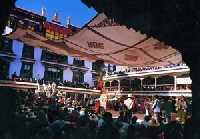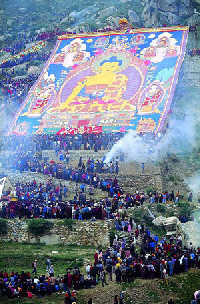| |
Zhaibung Monastery:Mother Monastery of Dalai Lama
( 2005-10-27 )
 The Zhaibung Monastery, which in Tibetan is called Duimi or Gyimi monastery and means "an auspicious land," sits at the southern slope gully of the Gebeiwoze Mountain about 5 kilometers west of downtownLhasain Southwest China's Tibet Autonomous Region. Jamyang Qoigyi Zhaxi Bendain, a favorite disciple of Gelug (Yellow) Sect founder Master Tsong Khapa, built the monastery in 1416. It is one of the six Gelug monasteries in China, but with the largest area and the highest status since it is the "mother monastery" of the Dalai Lama. The Zhaibung Monastery, which in Tibetan is called Duimi or Gyimi monastery and means "an auspicious land," sits at the southern slope gully of the Gebeiwoze Mountain about 5 kilometers west of downtownLhasain Southwest China's Tibet Autonomous Region. Jamyang Qoigyi Zhaxi Bendain, a favorite disciple of Gelug (Yellow) Sect founder Master Tsong Khapa, built the monastery in 1416. It is one of the six Gelug monasteries in China, but with the largest area and the highest status since it is the "mother monastery" of the Dalai Lama.
In 1409, Master Tsong Khapa successfully pioneered the Grand Summons Ceremony, also called Molan Qenmo in Tibetan, in Lhasa's Jokhang Monastery. In the same year, he built the Gandain Monastery built due to the popularity of the Gelug Sect among the Tibetan Buddhists. With the official rise of the Gelug Sect, the Zhaibung Monastery was built to accommodate the new situation. When the Zhaibung Monastery was built, Jamyang Qoigyi served as the first of its 23 abbots (also called "Chiba" in Tibetan).
In 1464, the Zhaibung Monastery set up Buddhist colleges, or Zhacang in Tibetan, for monks to learn Buddhist classics. During the period of the 5th Dalai Lama, the Gelug Sect set a ceiling on the number of monks for each Gelug monastery. The number for the Zhaibung was more than 7,700 monks, making the monastery the largest in Tibet - the Gandain and Sera monasteries had about 3,300 and 5,500 lamas respectively.
 The Zhaibung Monastery is composed of the Coqen Hall, four Zhacang colleges -- Losailing, Deyang, Ngaba and Gomang Zhacangs --, and the Gandain Phodrang (Palace). They formed the management organ that functioned under Coqen. The four colleges contain a total of 29 Kamcuns, groups of monks formed according to their origins. The Zhaibung Monastery is composed of the Coqen Hall, four Zhacang colleges -- Losailing, Deyang, Ngaba and Gomang Zhacangs --, and the Gandain Phodrang (Palace). They formed the management organ that functioned under Coqen. The four colleges contain a total of 29 Kamcuns, groups of monks formed according to their origins.
Located in the central part of the Zhaibung Monastery, the Coqen Hall covers an area of close to 4,500 square meters. In front of the hall is a stone-paved square. A 17-step stone staircase links the square with the hall. At the entrance are eight pillars. Coqen's Sutra Hall is of a magnificent scale, covering an area of 1,800 square meters and propped up by 183 pillars. All the Buddha statues enshrined in Coqen are lifelike, such as the statue of the Wisdom Buddha and a statue hidden under a whiteumbrellain the central part of Coqen.
There are two silver dagobas (dome-shaped Buddhist structure) in the wing chambers of the Coqen Hall. These are holy stupas for the 3rd and 4th Dalai Lamas. The Duisong Lakang (Hall) in the rear part of Coqen is the earliest of its kind in the Zhaibung Monastery. Jamyang Qoigyi Zhaxi Bendain used to meditate and study here. Now, the Duisong Lakang enshrines the statues of the 3rd Dalai Lama and two of his favorite disciples.
|
|

